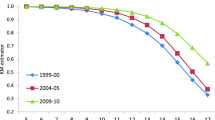Abstract
This paper attempts to examine the phenomenon of child labour in India by conducting a preliminary search for the factors which affect demand and supply of child labour. The incidence of child labour is firstly examined with respect to the socio economie characteristics including dernographic, educational and economie poverty variables. Factor analysis is then conducted to identify patterns of these variables with the incidence of child labour for Indian states using Census data. These possible relationships are formally modelled in an overlapping generations framework which derives two postulated models. The models are estimated using Kmenta’s pooled method which combines variations due to time and state specific factors. These results clearly indicate the presence of vicious and virtuous spirals consisting of the above factors for different states. The supply factors appear to dominate and their roles require further indepth examination
Similar content being viewed by others
Bibliography
Brown, M. Christiansen, J. and Philips, P., “The Defence of Child Labour in the U.S. Fruit and Vegetable Canning Industry: Law or Economics?” in Business History Review, Vol. 66, Winter 1992.
Caldwell, J.C., (1982), Theory of Fertility Decline, London: Academie Press.
Caldwell, J.C., (1990), The Soft Underbelly of Development: Demographic Transition in Conditions of Limited Economie Change: World Bank Annual Conference of Development Economics, 1990.
Chaudhri, D.P., (1996), A Dynamic Profile of Child Labour in India 1951–91, ILO, New Delhi.
Chaudhri, D.P., (1997), “Female Child Labour and Gender Bias in School Education in Indian States, 1961–92”, Indian Journal of Labour Economics, September–December 1997.
Chaudhri, D.P., (1997a), A Policy Perspective on Child Labour in India with Pervasive Gender and Urban Bias in School Education, an invited paper for the Annual Conference of the Indian Society of Labour Economics held at Trivandrum from January 2–4, 1998.
Chaudhri, D.P., (1997b), Child Labour in India in the Asian Perspective — 1951–1996 to appear in Social Change (Special Issue on Child Labour, forthcoming).
Chaudhri, D.P., (1997c), Challenge of Child Labour in Rural India: A Multi Dimensional Problem in Need of an Orchestrated Policy Response, a paper prepared for the workshop on Rural Child Labour, organised by the National Institute of Rural Development, Hyderabad, January 1998.
Chaudhri, D. P. and Wilson, E.J. (1997), Emerging Trends in Asian Agriculture: A Metaproduction Function Approach (1970–1992), Journal of Development Economics (under editorial consideration).
Crame, Jonathan (1997), The Epidemie Theory of Ghettos and Neighbourhood Effects on Dropping out and Teenage Child Bearing, American Journal of Soeiology, Vol. 96, No. 5, March 1991, pp. 1226–1259.
Dreze, J. and A. Sen (1995), India: Economie Development and Social Opportunity, Oxford University Press, New Delhi.
Dreze, J. and A. Sen (1995a), Basic Education as a Politicai issue, Journal of Educational Planning and Administration, Vol. IX, No. 1, January 1995, pp. 27–43.
Goonesekere, Savitri (1998), Children, Law and Justice: A South Asian Perspective, Sage Publications, New Delhi.
Haq, Mahbub-ul (1997), Human Development in South Asia, Oxford University Press, Karachi.
ILO (1996), Child Labour: Targetting the Intolerable, ILO, Geneva.
ILO (1996a), Lists of Ratifications by Convention andby Country, Report 3 (Part 5), ILO, Geneva.
ILO (1997), The ILO, Standard Setting and Globalization, Report of the Director-General Executive Summary, ILO, Geneva.
ILO (1997a), Address by Mr. Michel Hansenne, Director-General at the Parliamentary Assembly of the Council of Europe, Strabourg 26 June, 1997.
Kmenta, J., (1986), Elements of Econometrics, Second Edition, Macmillan Publishing Company, New York.
Nardinelli, C, (1990), Child Labour and the Industrial Revolution, Indiana University Press, Bloomington.
Rammohan, A., (1998), Interaction of Child Labour and Schooling in Developing Countries: An Alternative Formulation, Working Papers in Economics, 98-05, Department of Economics, University of Sydney.
Sen, A. K., (1996), Unit of Analysis, an invited address, Economie Society, South and South East Asia Chapter Meeting at Delhi, 28–30, December, to be published in Econometrica, 1997 (forthcoming).
Sen, A. K., (1997), Maximization and the Act of Choice, Econometrica, Vol. 65, No. 4, July 1997, pp. 745–779.
Stiglitz, Joseph (1996), Some Lessons from the East Asian Miraclejhe World Bank Research Observer, Volume 11, Number 2, August 1996, pp. 151–178.
Trattner, W.I., (1970), Crusade for the Children: A History of the National Child Labour Committee and Child Labour in America, Quadrangle Books, Chicago.
UNDP (1997), Human Development Report, Oxford University Press, New York.
UNICEF (1994), The Child and the Law, Papers from the International Conference on Shaping the Future by Law: Children, Environment and Human Health, New Delhi, March, 1994.
UNICEF (1995), The Progress of Indian States, UNICEF, New Delhi.
UNICEF (1996), Child Labour in Historical Perspective 1800–1985, UNICEF, International Child Development Centre, Florence.
UNICEF (1997), The State of the World’s Children 1997: Focus on Child Labour, Oxford University Press, New York.
United Nations (1989), Convention on the Right of the Child, UN, New York, Also reproduced in UNICEF (1994).
U.S. Department of Labour (1994), By the Sweat and Toil of Children, Vol. II; The Use of Child Labour in U.S. Agricultural Imports and Forced and Bonded Child Labour, a report to the Committee on Appropriation U.S. Congress, U.S. Department of Labour, Bureau of International Labour Affairs, Washington, D.C.
Visaria, P. and Jacob, P. (1995), Child Labour in India: Results ofa Methodological Survey in Surendranagar & Surat Districts of Gujarat State, Gujarat Institute of Development Research, Ahmedabad.
Rights and permissions
About this article
Cite this article
Chaudhri, D.P., Nagar, A.L., Rahman, T. et al. Determinants of Child Labour in Indian States: Some Empirical Explorations (19612–1991). J. Quant. Econ. 1, 1–19 (2003). https://doi.org/10.1007/BF03404645
Published:
Issue Date:
DOI: https://doi.org/10.1007/BF03404645




